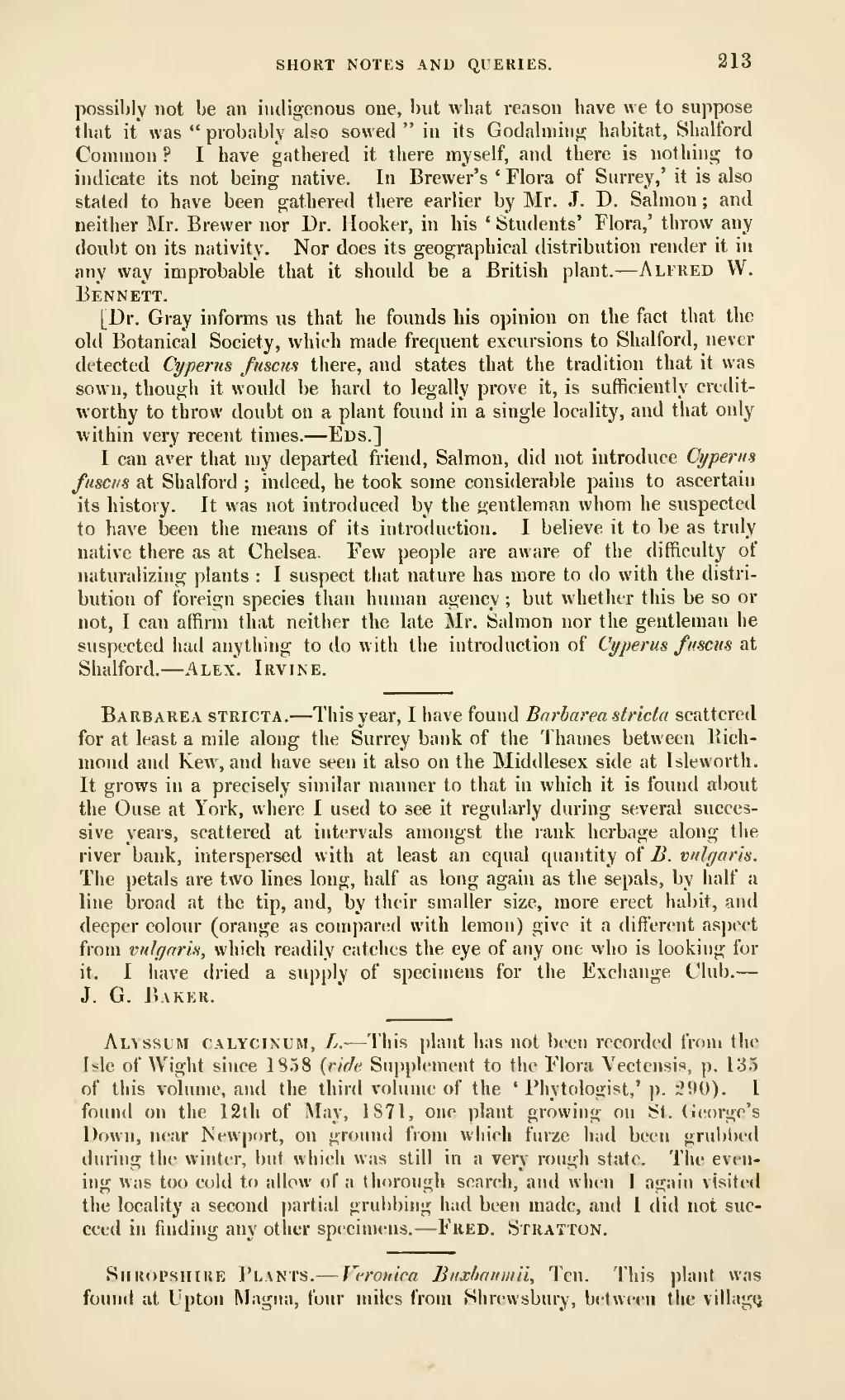SHORT NOTES AND QUEKIES. 213
possibly not be an indigenous one, but what reason have we to suppose that it was " probably also sowed " in its Godalming habitat, Shalford Common ? I have gathered it there myself, and there is nothing to indicate its not being native. In Brewer's ' Flora of Surrey,' it is also stated to have been gathered there earlier by Mr. J. D. Salmon ; and neither IMr. Brewer nor Dr. Hooker, in his ' Students' Flora,' throw any doul)t on its nativity. Nor does its geographical distribution render it in any way improbable that it should be a British plant. — Alfred W. Bennett.
[Dr. Gray informs us that he founds his opinion on the fact that the old Botanical Society, which made frequent excursions to Shalford, never detected Cyperus fuscm there, and states that the tradition that it was sown, though it would be hard to legally prove it, is sufficiently credit- worthy to throw doubt on a plant found in a single locality, and that only within very recent times. — Eds.]
I can aver that my departed friend, Salmon, did not introduce Cyperus fuse/is at Shalford ; indeed, he took some considerable pains to ascertain its history. It was not introduced by the gentleman whom he suspected to have been the means of its introduction. I believe it to be as truly native there as at Chelsea. Few people are aware of the difficulty of naturalizing plants : I suspect that nature has more to do with the distri- bution of foreign species than human agency ; but whether this be so or not, I can affirm that neither the late Mr. Salmon nor the gentleman he suspected had anything to do with the introduction of Cyperus fuscus at Shalford. — Alex. Irvine.
��Barbarea stricta. — This year, I have found Barbareastricta scattered for at least a mile along the Surrey bank of the Thames between Rich- mond and Kew, and have seen it also on the Middlesex side at Isleworth. It grows in a precisely similar manner to that in which it is found about the Ouse at York, where I used to see it regularly during several succes- sive years, scattered at intervals amongst the I'ank herbage along the river bank, interspei'sed with at least an equal quantity of B. vnlgaris. The petals are two lines long, half as long again as the sepals, by half a line broad at the tip, and, by their smaller size, more erect habit, and deeper colour (orange as compared with lemon) give it a different aspect from vulgaris, which readily catches the eye of any one who is looking for it. I have dried a supply of specimens for the Exchange Club. —
J. G. JiAKER.
��Alyssum calycinum, L. — This plant has not been recorded from the Isle of Wight since 1858 {vide Supplement to the Flora Vectensis, p. 135 of this volume, and the third volume of the ' Phytologist,' p. 290). I found on the 12lh of May, 1S71, one plant growing on St. (ieorge's Down, near Newport, on ground from which furze had been grubl)ed during the winter, but which was still in a very rough state. The even- ing was too cold to allow of a thorough search, and when 1 again visited the locality a second |)artial grubbing had been made, and I did not suc- ceed in finding any other specimens. — Fred. Stratton.
Shropshire Flani's. — Veronica Btixhauniii, Ten. This ])lant was found at Upton Magna, four miles from Shrewsbury, between the villagii
�� �
